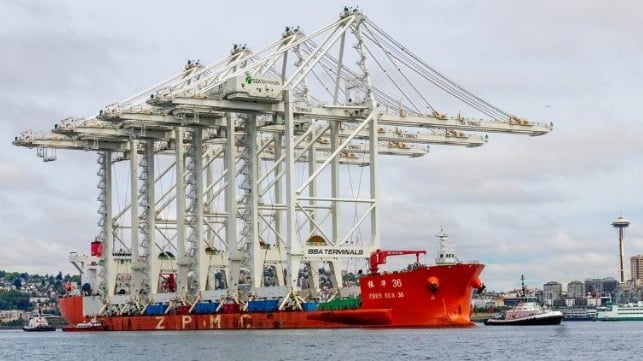U.S. Moves Forward with Sweeping Tariffs on China Including Port Cranes

The United States Trade Representative announced on Friday it has completed its review of the sweeping tariff increases proposed by the Biden Administration on a wide range of Chinese goods including ship-to-shore cranes used in most American ports. The Trade Representative had delayed implementation until completing a review and making some modifications, which included a partial win for the American Association of Port Authorities (AAPA).
The tariffs cover a wide range of Chinese goods ranging from semiconductors and steel and aluminum products to electric vehicles and their batteries, permanent magnets, and a range of medical products including gloves, facemasks, and syringes. Most of the tariffs start immediately while others phase in during 2025 and 2026.
The Trade Representative determined to increase the tariffs on Chinese-made ship-to-shore cranes to 25 percent effective in 2024. However, it added an exclusion for contracts executed prior to May 14, 2024, and cranes that enter the United States prior to May 14, 2026.
Ports and the port association argued that making the tariffs effective immediately was punishing U.S. port operators without a strong alternative. They said it would raise the costs for port operators or possibly delay critical port infrastructure investments. The Trade Representative confirmed that comments argued it would not be effective in the elimination of China’s acts and policies in part due to the current dominance of China over the industry.
China’s state-owned Shanghai Zhenhua Heavy Industries (ZPMC) is the target of all the complaints as the company is reported to supply 80 percent of all STS cranes ordered by U.S. ports. The company claims to have 70 percent of the global market which prompted the Biden administration earlier this year to reshore a portion of the manufacturing in the U.S. and support competitive offers to ZPMC.
AAPA in July said at least seven U.S. ports currently had 35 STS cranes on order from Chinese manufacturers. All these orders they argued were signed before the tariff was announced. AAPA calculated that the tariff would cost the ports an additional $131 million in new and unexpected costs. AAPA was collecting data on anticipated future purchases but said it had already learned of plans to buy at least 61 additional STS cranes.
“The exclusion balances the possible impact on the U.S. economy with the security interests of the United States from the threat of Chinese state-sponsored cyber intrusions of critical infrastructure,” said the Trade Representative announced its decision.
The hysteria of Chinese-manufactured cranes began in 2023 with accusations of “spy cranes” and remote-control opportunities. Reports said inspections have found cellular modems, giving them an independent connection that bypasses the port's local area network. Last week, a U.S. House of Representatives subcommittee released a report on the threats it perceives from the cranes.
AAPA has repeatedly tried to downplay the threats. They argue there are no examples of interference and that limited information is available to the crane and its operator such as the contents of the boxes. Despite that, the Biden administration in February ordered a review and gave the U.S. Coast Guard new authorities for cybersecurity and port operations.
The White House in February reported an agreement with PACECO Corp., a U.S.-based subsidiary of Japan’s Mitsui E&S Co., which they said was planning to relaunch a U.S. manufacturing capability for cranes after an absence of more than 30 years. More recently, Finnish-based port equipment manufacturer Konecranes said it was establishing a supplier network including U.S. steel to build STS cranes in the United States.
